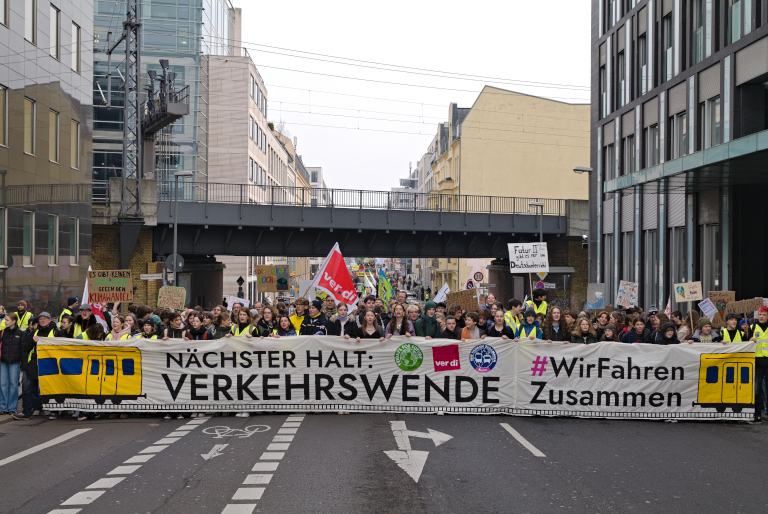Copyright Resilience

Forging new alliances between previously disjointed social movements has the potential to significantly build their popular power. The story of Germany’s “Wir Fahren Zusammen” coalition shows how these alliances might be built in practice. In the current moment of the polycrisis-climate breakdown, global injustice and the ascent of the far right- the climate movement, just like any other progressive cause, is facing existential challenges and needs allies more than ever. To build the popular power necessary for a just and resilient future, we must forge new and sometimes unexpected alliances. In this article I argue that for the climate movement specifically this means to build bridges with a group of people it has historically been pitted against: the working class. The Climate-Labour Division The working class: a major social group in any industrialised country, and historically a left-wing subject at the centre of demands for a worker controlled economy and better welfare, is now a growing base of support for right-wing parties. It is becoming essential for their electoral success across Europe, courted by these parties’ seeming concern for protecting wealth and jobs.[1] Climate activists on the other hand are increasingly demonised as fanatic eco-terrorists in mainstream media whose demands are framed as extremist and harmful to working people, making them seem like an out-of-touch elite of students and academics. This framing and the division between the climate movement and working class are not accidental, nor are they new. As Ellen Russell outlines, capitalist forces like to employ a strategy of “divide and conquer,” pitting labour and climate actors against each other through narrative strategies, to protect their profits in the face of these two movements whose combined power would be to capital’s detriment, once they realise it as their common enemy.[2] History has shown us, from the anti-apartheid struggle to the civil rights movement, that when different movements recognise their common enemy, they will generate the power to topple the status quo. The crucial question however is: How can we bridge these divides and make these alliances happen? A Case Study in Solidarity: “Wir Fahren Zusammen” For my Master’s thesis, I spent several months interviewing unionists and climate activists from Germany who took part in the climate-labour coalition “Wir Fahren Zusammen” (WFZ) (we drive/ride together). It was an alliance between the public transport department of the German labour union ver.di and Fridays for Future Germany (FFF), active in over 70 cities in Germany between 2020 and 2024.[3] This unexpected alliance came to be after a strategic deliberation within Fridays for Future and the broader climate movement. The negative effects of the media discourse I outlined above were felt, as well as a waning effectiveness of past tactics like the school strikes. Inspired by calls from academics and activists for a “labour turn” in the climate movement, as well as the “Organising for Power” course by the Rosa Luxemburg Stiftung many had attended, a group of FFF activists decided to approach ver.di and suggest a collaboration of their organisations.[4] Unions in Germany are strictly banned from including political demands in their strikes. That is why the collaboration with FFF was a chance for ver.di to actually have a political platform for their demands for increased investment into the struggling German public transport sector. In practice, the collaboration meant that union staff and volunteers worked together with climate activists to recruit workers in public transport for strikes and action days. The strikes were focused on labour demands like better pay and working conditions, while the action days and FFF-organised demonstrations were focused on the political demand for better climate protection through increased investment in public transport. From what the participants of the coalition shared with me in the interviews, and through analysing documents used in their work, I have summed up some conclusions and possible lessons for other organisers on how to make such alliances successful, and what effects they have on their participants both from a working and climate background. Overcoming the Divide: Lessons from the Picket Lines The interviewees told me that initially, there was a lot of hesitation on the side of the workers when it came to uniting with climate activists. They had been subject to a rather defensive position about the green transition in their unions and for many, their only reference for a climate activist was the TV image of a young person gluing themselves to the street. The divide and conquer strategy I mentioned earlier had been effective. Two mechanisms were decisive in overcoming this hesitation: Find a material base for unity: The coalition was successful because it was built on a tangible, shared interest. The workers’ support for the climate movement’s demands came out of the material connection established between these demands and the defence of their own working and living conditions. Namely, public transport contributes to the lowering of carbon emissions, therefore the interest of the climate movement advocating for less emissions in the transport sector naturally aligned with the interests of workers in the sector for more investment and better working conditions. Through many conversations with climate activists at the picket lines, in union meetings and spontaneous visits at the depots, the transport workers began to understand that their labour as bus and tram drivers is essential in the just green transition, and that their working conditions are in essence a climate concern. This fundamentally changed their self-understanding as essential, powerful subjects of the sustainable transition. This points to two lessons: On the one hand, workers in sectors that will need to grow in the green transition -such as public transport- as perfect allies for the climate movement. On the other hand, we need to advocate for climate measures that benefit the workers of sectors that need to phase out in the transition. It cannot be a just transition if it does not benefit the working class’s living conditions. Only then will the transition gain widespread support. Solidarity needs to be felt: An essential practice to build the relationship between climate activists and workers and to overcome the initial hesitation, was strong solidarity with the workers’ cause coming from the young climate activists. Interviewees who worked as bus and tram drivers told me how emotional it was for them to be joined by a big group of young climate activists at the picket line. They tangibly experienced the activists’ solidarity for their labour demands when those same activists kept showing up to the picket line early in the morning throughout multiple bargaining rounds, sharing coffees and conversations. While not without its challenges, these were moments when unlikely friendships formed between people of very different ages, class backgrounds and even political ideologies. Transformative Outcomes: Consciousness and Praxis It was not only the workers who were opened up to new perspectives, and who overcame their hesitations about their coalition partner. Interviewees with a background in climate activism also talked about their own transformation. Through their conversations and close contact with unionists, the activists who were formerly exclusively involved with climate issues, broadened their perspective to include working class concerns, like the undervaluation of work and the financial strain of certain climate policies. This led to a steadfast solidarity with their working class coalition partners and a class consciousness they previously did not have. This kind of environmentalism that centres the protection of workers’ living and working environment, and ultimately the thriving of humanity which necessitates an intact ecosystem and just social conditions, is labelled as “working class environmentalism” by scholar Stefania Barca. When the WFZ coalition ended its work in 2024, it became clear that its participants had not only undergone a transformation of their consciousness, but also their activism. Many of the climate activists actually continued to be involved in labour and working class struggles after their time in the coalition. Some of my interviewees stated that they feel as close to the labour movement as the climate movement these days. My interviewees who worked as bus and tram drivers expressed that the personal transformation they went through in the coalition made them more motivated and confident to increase their political praxis, especially in their union where they see much potential in strengthening its political character toward engaging with the green transition in a worker-centred way. In the case of one of the interviewees this meant rising up to a decision-making role in the union. Forging Resilient Movement Alliances In conclusion, the lessons from Wir Fahren Zusammen are clear. Overcoming the ‘divide and conquer’ strategy requires two key ingredients: first, a material basis for unity, where climate demands benefit workers’ living and working conditions; and second, the patient, relational work of real solidarity, built on picket lines and over shared coffees. The story of WFZ is more than just a successful campaign; it can be an inspiration for any labour and climate organiser, especially in the current moment when new strategies and alliances are needed to meet the challenge of the polycrisis and an increasingly right-wing working class. Evaluating practical experiences of coalition building and taking seriously the wisdom of workers and activists engaged in this work is crucial. In a political landscape intent on pitting the climate and labour movements against each other, WFZ demonstrated that such an alliance is not only possible but deeply transformative for those who participated. The key task now is to apply these lessons. As climate activists, we need to move beyond single-issue campaigns, and make solidarity with others who are facing the brunt of the destructive capitalist system a central pillar of our movement. Even if they appear very different from us at first sight. [1] Jäger, Anton. (2024). Unpacking Working-Class Reaction. Rosa Luxemburg Stiftung. https://www.rosalux.de/en/news/id/52626/unpacking-working-class-reaction. [2] Russell, Ellen D. (2017). Resisting Divide and Conquer: Worker/Environmental Alliances and the Problem of Economic Growth. Capitalism Nature Socialism, 29 (4): 109–28. [3] Niederman, Aaron. (2025). Four Key Ingredients for a Just Transition. Rosa Luxemburg Stiftung. https://www.rosalux.de/en/news/id/53322/four-key-ingredients-to-ajusttransition#:~:text=Between%20these%20four%20factors%20%E2%80%94%20an,to%20win%20a%20just%20transition [4] Pye, O. (2017). Für einen labour turn in der Umweltbewegung: Umkämpfte Naturverhältnisse und Strategien sozial-ökologischer Transformation. PROKLA. Zeitschrift für Kritische Sozialwissenschaft, 47(189), 517 – 534. https://doi.org/10.32387/prokla.v47i189.54 Image credit: Wir fahren zusammen protest Berlin 2024-03-01 main demonstration 66″ by Leonhard Lenz is marked with CC0 1.0. The banner reads: “next stop: mobility transition”



